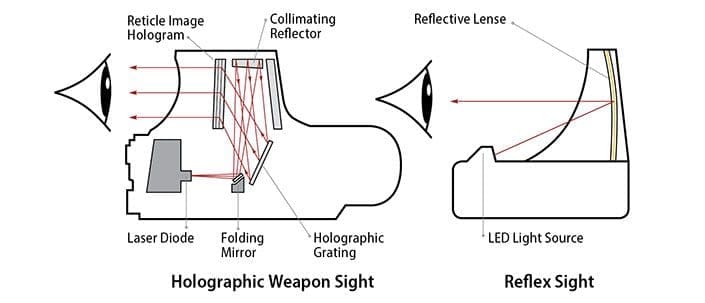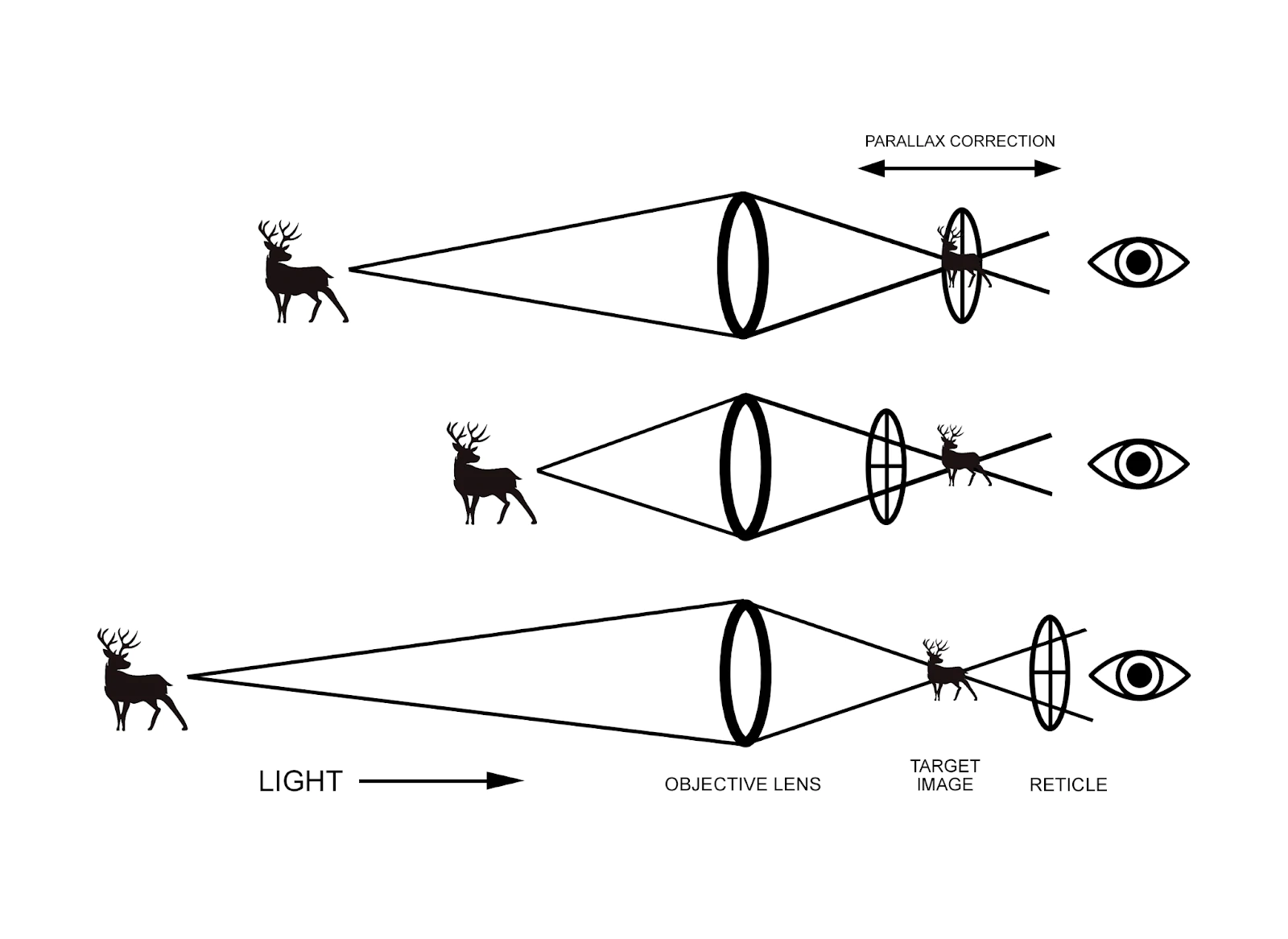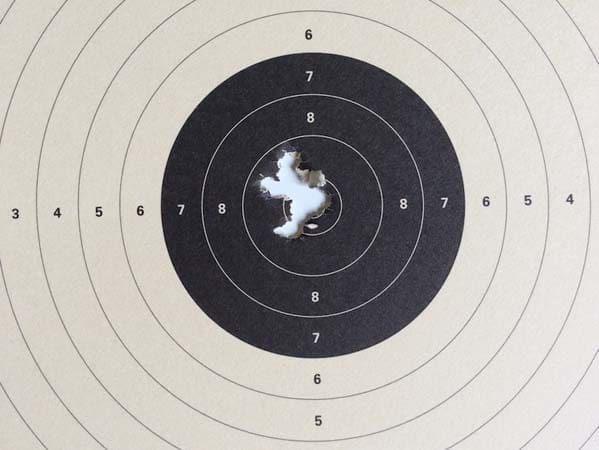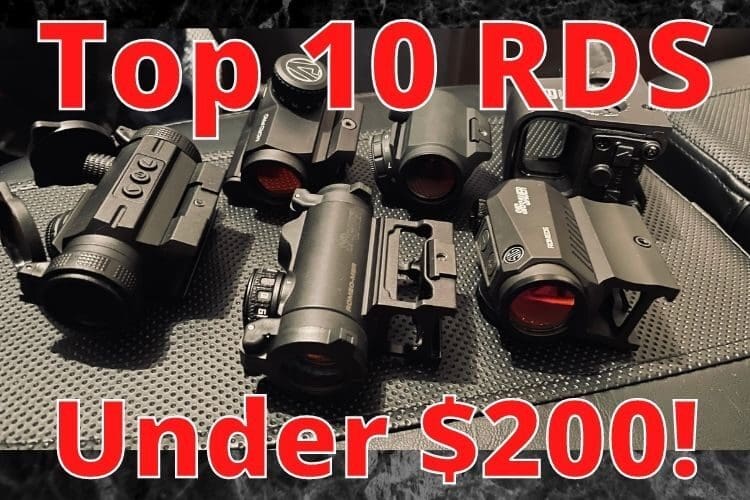If you’re new to red dot sights, and the myriad of optic types to mount on your AK, you may not be aware that one of the most popular optics for AK rifles and AK pistols is red dot sights. In this beginner’s guide to AK optics with red dot sights explained, we answer 11 of the most commonly asked questions regarding red dot sights and explain the differences between red dot sights, holographic sights, and prism scopes.
We also cover optics terminology to get you caught up on the industry jargon, give you the pros and cons of red dot sights, and discuss the pitfalls of buying cheap, low-quality red dot sights.
What is a Red Dot Sight & How Do They Work?
A red dot sight, or RDS for short, is a type of optic that projects a red, green, blue (or other) colored dot, circle, crosshair, (or other) reticle onto the glass of the open or enclosed lens at 1X power (without magnification) via an LED diode. They operate via a power source such as a battery, (button-cell, AA, or AAA), fiber optic, or solar panel.
Types of Red Dot Sights:
The two types of Red Dot Sight are defined by their enclosure or lack thereof. Tube sights are fully enclosed just like Holographic Sights and LPVO optics, and the emitter is located between the front and back glass. Open sights are not enclosed and the emitter is located at the back of the sight, which makes it vulnerable to dust, dirt, mud, and rain.
Open red dots are often referred to as “reflex” sights because they have a larger field of view (FOV), whereas enclosed red dots have a narrower FOV due to their tubular design. Having a larger FOV makes it easier to find the dot on the sight and lends itself to a quicker sight picture. Shooting with both eyes open helps to mitigate the limitations of the tubed design to a good degree.
Within the open and closed designs, there are two subcategories: Trijicon RMR (Ruggedized Miniature Reflex sights) or RMS & RMSc cuts are primarily made for mounting on pistols that have an RMR, RMS, or RMSc cutouts with various mounting plates to fit specific brands. Micro Reflex/ Red Dot Sights, or MRDS, are the compact modern versions of the older generation Red Dot Sights- both were designed for use on rifles and shotguns.
Are Holographic Sights & Prism Scopes the Same as Red Dots?
In principle, they are very similar but in design, they are totally different. They are all capable of projecting a “red dot” but the way in which they do that is what makes them differ. Holographic sights project the reticle using a laser that reflects off of a series of mirrors and presents a reticle that appears holographically superimposed on the target. This method of producing a reticle works even in the absence of glass. The glass on holographic sights is there to keep the elements out.


Red dot sights, aka “reflex” sights, project the reticle directly onto the lens of the glass that is then directed back at the eye. Without a glass lens, a reflex sight could not work. That’s also why reflex sights must have mirror-coated glass for the projection to be reflected back toward your eye. This coating also reduces glare from the sun and minimizes reflections off of the front of the glass. By contrast, holographic sights have clear glass that does not tint the sight picture because they lack a mirrored coating.
Prism Scopes are unique because they don’t project light onto anything. Instead, they use an etched reticle in the center glass panel and light up only the outline of the etching. This is advantageous if you run out of battery since the etching in the glass can still be used (much like a scope) in daylight conditions.


Another advantage of prism scopes is that they produce a very sharp reticle that is not affected by eye conditions like astigmatism. Many prism sights offer 3X magnification so they have more in common with LPVOs (low-power variable optics) than they do reflex sights. They’re like a hybrid between a red dot sight and a lighted reticle scope.
What Are Eye Relief, Eye Box, FOV, & Parallax?
These are all terms having to do with what and how you see through the glass. Let’s start with eye relief.
Eye Relief:
This tells you how close your eye has to be to the glass in order to see the reticle and the sight picture clearly through the lens. Since reflex red dots use only one or two lenses, eye relief on these sights is virtually unlimited. This means you can mount this type of optic as far back or forward as your rail will allow.




Eye Box: This term refers to how far your eye can stray from the center of the glass before you lose sight of the reticle. Reflex sights have a large eye box compared to LPVOs and traditional rifle scopes but some red dot sights have a larger eye box than others depending on their size. The smaller the glass window, the smaller the eye box will be.
FOV (Field of View):
With one eye closed, the field of view on a magnified, or unmagnified optic, will be equivalent to the size of objective lenses. Because red dots can be used with both eyes open, FOV can be technically unlimited but, when using red dots with one eye closed, the field of view will be roughly equivalent to the size of the glass window being looked through.


Parallax Shift: This is the phenomenon you experience when your head isn’t perfectly centered on the optic. This will have a negligible effect on your POI (point of impact) on most well-made red dot sights. Though many claim their sights are “parallax free”, there is always going to be some parallax introduced when shifting your head off of center. Fortunately, the human eye will naturally line up the dot at or near the center of the glass every time… with a little bit of practice!


What are the Pros & Cons of Using a Red Dot Optic?
Generally speaking, red dot optics are purpose-built with quick target acquisition under stress scenarios being the prominent use factors. Take, for instance, most self-defense situations, and search & rescue training drills in hostile environments as the primary examples of where and when red dot sights are employed more than any other optic.
They are a step above Tritium day & night sights, and well above standard AK iron sights when it comes down to how quickly you can acquire your target. Like standard iron sights, they provide no magnification to help you see a target further away and are meant to be used for CQB (close-quarters battle) but typically not much further than 50-100 yards away, in most cases.
Of course, you can still find and hit targets well beyond the recommended limits. Red dot optics can be used well beyond 200 yards with the addition of flip-mount magnifiers but, without some magnification, it’ll be hard to identify that target as a threat!
Below are our Pros & Cons of using red dot optics on your AK:
Pros:
- Lightweight- depending on type and model
- Smaller size- again, some older designs are larger and heavier than compact versions
- Faster target acquisition
- Best for CQC scenarios
- Wide FOV- especially for the open reflex designs that allow easy use with both eyes open
- Simple reticle designs- nothing complicated to look at here! Just a dot, circle, or some combination of the 2 with some crosshairs added for good measure.
- Long battery life- most models employ the use of LED emitters that, depending on battery type, can last for thousands of hours of constant use. Of course, the manufacturer’s specified ratings are on the lowest power settings- so keep that in mind.
- Many decent options for those on a limited budget
Cons:
- Not the best option for those with astigmatism
- Reduced MOA accuracy compared to scopes
- Not as effective at distances beyond 300 yards without the use of magnification
- Useless if the battery dies
- Lots of cheap, Chinese garbage brands on the market that break easily and can’t hold zero (or even be zeroed!)
- Can do one thing well while other scopes can do multiple things well
- Some are definitely not as durable while others are built like a tank
Are Cheap Red Dot Sights Any Good?
Short answer- not really. Most, if not all of these cheaper Chinese brands, seem to be suited more towards airsoft use than anything with actual recoil. The kicker is that they often don’t bother to tell you if it can handle real firearm recoil or if it’s just a glorified toy that only looks the part. Don’t be fooled by the specs on these cheaper red dot sights that may look good in photos but don’t cut the mustard.
These low-quality red dot sights are plagued with problems straight out of the box. They typically will not hold zero (or be zeroed at all), the dot is fuzzy, misaligned, or blown out, and dropping them will most certainly result in irreparable damage. Also, they tend to eat through batteries even when they’re turned off! Our advice is to save your money and save up for something that was built to quality control standards. As the saying goes, “Buy once, cry once”…
Don’t get me wrong, there are some very good red dot sights that are made in China, but most of those are working closely with companies that demand higher quality controls before shipping them to the end-user while offering a warranty to back their products.
“But what about mid-grade, mid-tier, or mid-priced Chinese red dot sights?”, you ask.
Well, right out of the gate I’m going to eliminate for you the open, reflex-type, Chinese red dot sights as viable options. Period. They really are junk no matter how you slice it. What I’m focusing on here are the tube-style red dots that can usually be found between the $25-$50 price range. In this price range, you’ll find many of the same features and specs in a multitude of styles and accessories.
Most, if not all, will be made out of less-than-stellar grades of metal alloy that most people refer to as “Chinesium”. Some jest that Chinesium consists of metals not found on the Periodic Table of Elements that, hilarious as it sounds, is obviously not true! All jokes aside, I’ve compiled a list of comparisons between these “mid-grade” Chinese red dot sights (with almost comical logos slapped on them) and their higher-quality counterparts (those also made in China but with good QC).
Mid-Grade Generic Chinese Branded Red Dots:
- LED diodes are less efficient therefore battery life is much lower
- Cheaper logic boards with poor soldering and zero-to-low weatherproofing
- Fit and finish may look nice but will not hold up over time
- Are not made from high-grade aluminum but cheaper Chinesium alloys
- MOA adjustments may lack tactile “clicks” and zero may not hold under fire (or be impossible to zero)
- Dots tend to lose definition the brighter the setting (some higher-cost RDSs exhibit this to some extent but not as bad)
- The red dot may be washed out under bright daylight thus making it hard to see
- Turrets will usually have caps but will otherwise not be protected from falls or blunt force
- Lens coating doesn’t eliminate glare completely and lacks adequate anti-reflective properties
- Suspect waterproofing ratings that may or may not hold true
- Led emitter breaches out into the sight picture (some worse than others)
- Are not as resistant to shock
- Built-in mounts are susceptible to bending or cracking due to the “Chinesium” alloys used
As you can see by my list of cons, there are a lot of reasons to avoid these cheaper mid-grade, insert-random-company name-here, Chinese optics if you can afford to spend just a few more Jacksons on something better (with actual quality control protocols being strictly adhered to).
Are Red Dot Sights Accurate?
Red dot sights mounted on an AK can be accurate enough in the right hands but were never meant to replace magnified scopes. Red dot sights with a 1 MOA dot can achieve higher accuracy than red dot sights with larger dots, generally speaking, but are harder to see in bright settings. With enough practice, red dot sights can offer the shooter a better sight picture than plain AK iron sights- and can even co-witness with AK sights when mounted to a railed gas tube.


Micro red dot sights use smaller glass which can make it harder still to see the dot if your head is an inch too far left or right. Larger red dot sights shrouded in a nitrogen-purged tube allow you to see the dot even if your head isn’t perfectly centered behind the optic. Learning to shoot red dot sights with both eyes open can alleviate some of the issues that cause parallax shifts and narrow your field of view.
What Does MOA Mean?
Most red dot sights mention the size of the dot in terms of its MOA which stands for a “minute of angle”. The red dot sight’s advertised MOA is the smallest the dot can get on normal brightness settings but can grow a bit larger when turned up to its maximum brightness. This dot growth is most apparent in low-light environments but in broad daylight will have a minimal effect on the advertised MOA.
For this reason, it is generally recommended that you pick an MOA dot size that is the most appropriate for your needs. Larger dots (4-6 MOA) are much easier to acquire- especially on close-up or moving targets. Smaller dots (from 1-2 MOA) are generally recommended where more precision is required or targets are much further away. If you’re unsure which dot size to go with, finding a red dot sight with 2-3 MOA is a nice middle-ground that can fill just about any role but may not be perfectly suited for every one of them.


So, in summation, larger MOA dots (4-6 MOA) are better for closer targets and moving targets out to 55 yards (they’re also recommended for those with poorer eyesight). Medium MOA dots (3 MOA) are good all-rounders that are good enough for up-close target acquisition and can reach out well past 55 yards without covering up the target too much to get an accurate shot off. The smallest MOA dots (1-2 MOA) is best for precision shots at medium to long-range targets, where accuracy is a must if you want to place your shots as close to your point of aim as possible.
Here’s a breakdown of what MOA is and how it’s implemented: (source nssf.org)
A Minute of Angle (MOA) is an angular measurement.
An MOA is 1/60th of a degree.
1 MOA spreads about 1″ per 100 yards. (actually 1.047″)
1 MOA is a different size at different distances, 8″ at 800 yards is still just 1 MOA.
| 100 yds | 200 yds | 300 yds | 400 yds | 500 yds | 600 yds | 700 yds | 800 yds |
| 1″ | 2″ | 3″ | 4″ | 5″ | 6″ | 7″ | 8″ |
Are Red Dot Sights Fog Proof?
So, is your red dot sight really fog-proof? On the inside- YES. On the outside- NO! When manufacturers say their optics are “fog-proof” they’re not lying, per se, but that leads the consumer to assume that “fog-proof” means the lenses never fog. Manufacturers should state that no optic is fog-proof on the outer glass but only on the inside glass! If an optic is nitrogen-purged (as most are), and properly sealed (if well-made), it will keep the glass from fogging up internally. Any internal fogging would make the optic effectively useless.
That’s why a high IPX rating is a must and quality weatherproofing seals should be installed, or you’ll likely end up with an awkward paperweight. If you find yourself in colder climates or moving between hot areas to cold areas, your glass will fog up. It will not affect your red dot’s performance so long as you wipe the moisture off the glass.
Waterproof vs IPX Rated?
Most well-made red dot sights from reputable manufacturers should be waterproof while more expensive options have an actual IPX7 rating, (which is good for submersion up to 1 meter for 30 minutes). If a red dot sight lacks an actual rating that doesn’t mean it’s not waterproof… it simply means it has not been “tested” for submersion or water-jetted. If it lacks an IPX rating, we recommend its use be constrained to light, intermittent, or moderate rain ONLY. Don’t waterboard your optic without an IPX7 rating!
What is Co-Witness?
Considered to be the “Holy Grail” in AK circles, co-witnessing on an AK is a no-go for most optics/rail combos. So what is Co-Witness exactly? There are two types of co-witness configurations with red dot sights: Absolute Co-Witness and Lower 1/3 Co-Witness.
Co-Witnessing is the ability to view your iron sights through the optics glass either perfectly aligned with the front post of your irons or slightly above it.


Above is a graphic that shows you what an absolute co-witness and a lower 1/3 co-witness look like through a red dot sight.
Can You Co-Witness on an AK?
You can get an optic with a direct mount (without a riser) to co-witness on an AK by using either a railed gas tube or a side rail mount that sits snugly over your dust cover. Smaller optics mounted this way can achieve a lower 1/3rd co-witness.
We hope you’ve gained enough knowledge now to confidently pick a red dot sight that you know will serve you well on your AK! If you’re still not sure which red dot sight to pick up, check out this article that covers our top picks for red dot sights for your AK under $200!



